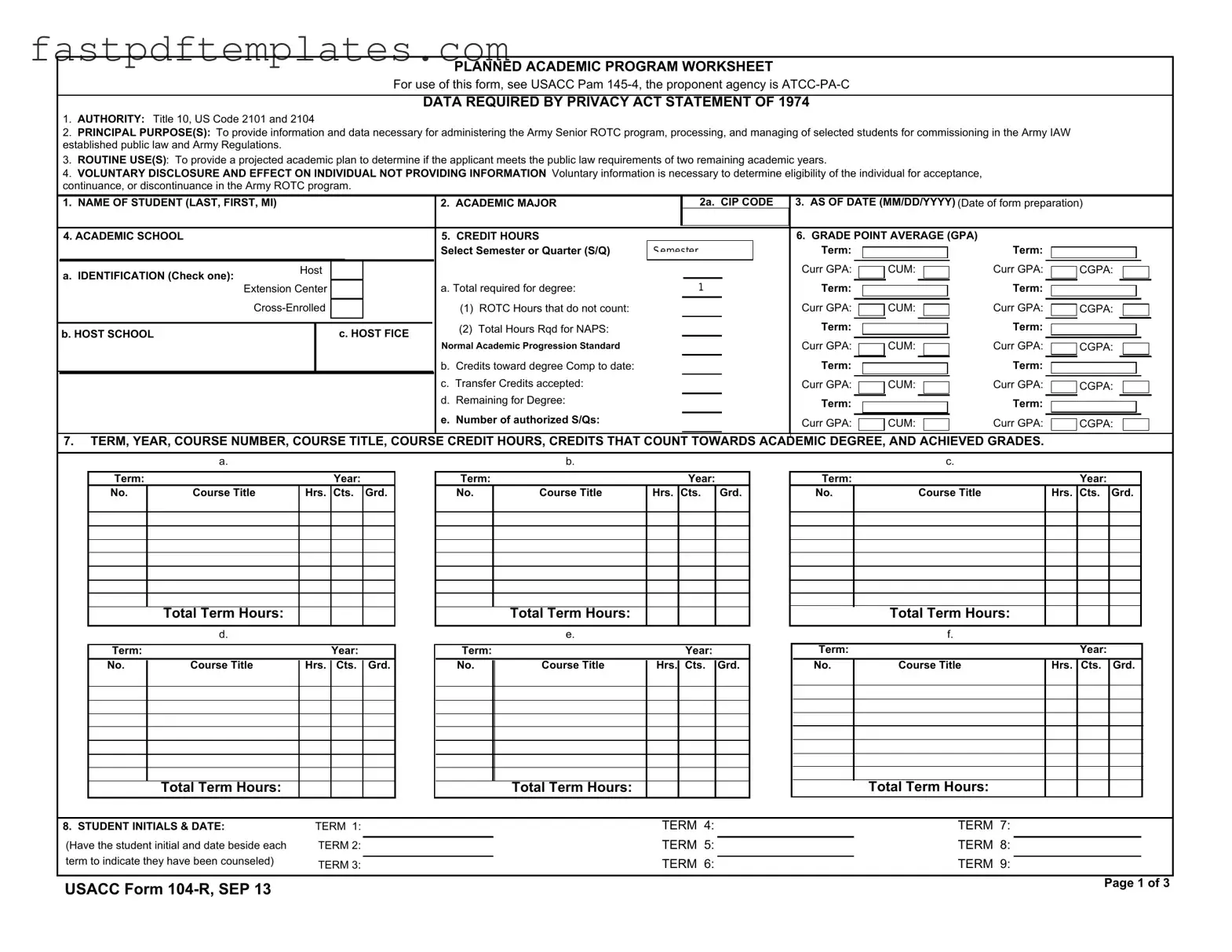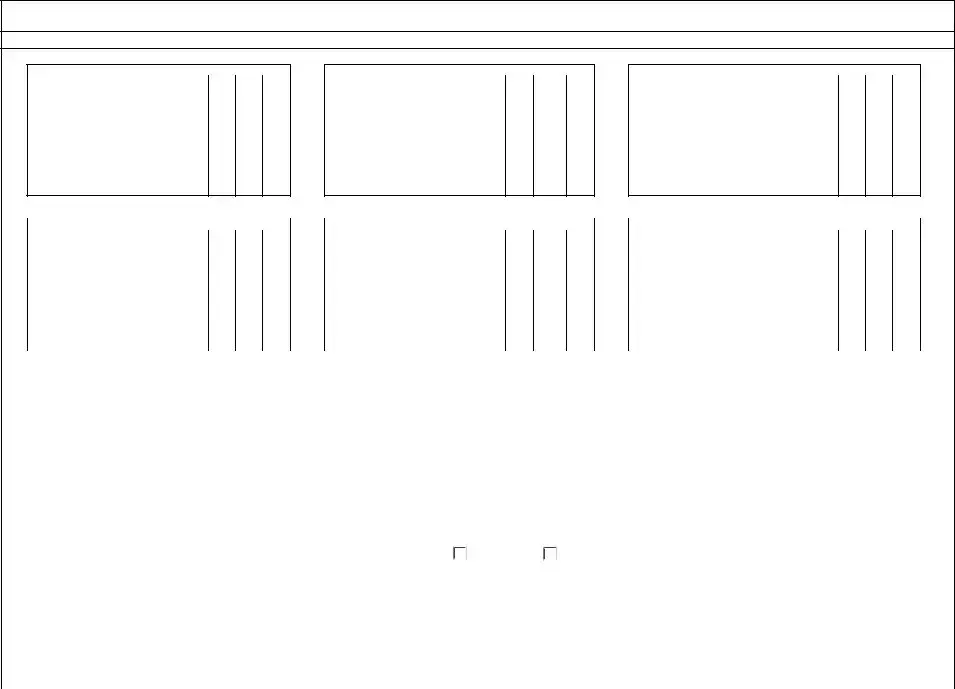
PLANNED ACADEMIC PROGRAM WORKSHEET
For use of this form, see USACC Pam 145-4, the proponent agency is ATCC-PA-C
DATA REQUIRED BY PRIVACY ACT STATEMENT OF 1974
1.AUTHORITY: Title 10, US Code 2101 and 2104
2.PRINCIPAL PURPOSE(S): To provide information and data necessary for administering the Army Senior ROTC program, processing, and managing of selected students for commissioning in the Army IAW established public law and Army Regulations.
3.ROUTINE USE(S): To provide a projected academic plan to determine if the applicant meets the public law requirements of two remaining academic years.
4.VOLUNTARY DISCLOSURE AND EFFECT ON INDIVIDUAL NOT PROVIDING INFORMATION: Voluntary information is necessary to determine eligibility of the individual for acceptance,
continuance, or discontinuance in the Army ROTC program.
|
1. NAME OF STUDENT (LAST, FIRST, MI) |
|
|
|
2. ACADEMIC MAJOR |
|
|
2a. CIP CODE |
3. AS OF DATE (MM/DD/YYYY) (Date of form preparation) |
|
|
|
|
|
|
|
|
|
|
|
|
|
|
|
|
|
|
|
|
|
|
|
|
|
|
|
|
|
|
|
|
|
|
|
|
|
|
|
|
|
|
|
|
|
|
|
|
|
|
|
|
|
|
|
|
|
|
|
|
|
|
|
|
|
|
|
|
|
4. ACADEMIC SCHOOL |
|
|
|
|
|
5. CREDIT HOURS |
|
|
|
|
|
6. GRADE POINT AVERAGE (GPA) |
|
|
|
|
|
|
|
|
|
|
|
|
|
|
|
|
|
|
Select Semester or Quarter (S/Q) |
Semester |
|
|
|
Term: |
|
|
|
|
|
|
|
|
|
Term: |
|
|
|
|
|
|
|
|
|
|
|
|
|
|
|
|
|
|
|
|
|
|
|
|
|
|
|
|
|
|
|
|
|
|
|
|
|
|
|
|
a. IDENTIFICATION (Check one): |
Host |
|
|
|
|
|
|
|
|
|
Curr GPA: |
|
|
|
CUM: |
|
|
Curr GPA: |
|
|
CGPA: |
|
|
|
|
|
Extension Center |
|
|
|
a. Total required for degree: |
|
|
1 |
|
|
Term: |
|
|
|
|
|
|
|
|
|
Term: |
|
|
|
|
|
|
|
|
|
|
|
|
|
|
|
|
|
|
|
|
|
|
|
|
|
|
|
|
|
|
|
|
|
|
|
|
|
|
|
|
Cross-Enrolled |
|
|
|
(1) ROTC Hours that do not count: |
|
|
|
|
|
Curr GPA: |
|
|
|
CUM: |
|
|
Curr GPA: |
|
|
CGPA: |
|
|
|
|
|
|
|
|
|
|
|
|
|
|
|
|
|
|
|
|
|
|
|
|
|
|
|
|
|
(2) Total Hours Rqd for NAPS: |
|
|
|
|
|
Term: |
|
|
|
|
|
|
|
|
|
Term: |
|
|
|
|
|
|
|
|
|
|
|
b. HOST SCHOOL |
|
|
c. HOST FICE |
|
|
|
|
|
|
|
|
|
|
|
|
|
|
|
|
|
|
|
|
|
|
|
|
|
|
|
|
|
|
|
|
Normal Academic Progression Standard |
|
|
|
|
|
Curr GPA: |
|
|
|
CUM: |
|
|
Curr GPA: |
|
|
|
|
|
|
|
|
|
|
|
|
|
|
|
|
|
|
|
|
|
|
CGPA: |
|
|
|
|
|
|
|
|
|
|
b. Credits toward degree Comp to date: |
|
|
|
|
|
Term: |
|
|
|
|
|
|
|
|
|
Term: |
|
|
|
|
|
|
|
|
|
|
|
|
|
|
|
|
|
|
|
|
|
|
|
|
|
|
|
|
|
|
|
|
|
|
|
|
|
|
|
|
|
|
|
|
|
|
|
|
c. Transfer Credits accepted: |
|
|
|
|
|
Curr GPA: |
|
|
|
CUM: |
|
|
Curr GPA: |
|
|
CGPA: |
|
|
|
|
|
|
|
|
|
|
|
|
|
|
|
|
|
|
|
|
|
|
|
|
|
|
|
|
|
|
|
|
|
d. Remaining for Degree: |
|
|
|
|
|
Term: |
|
|
|
|
|
|
|
|
|
Term: |
|
|
|
|
|
|
|
|
|
|
|
|
|
|
|
|
|
e. Number of authorized S/Qs: |
|
|
|
|
|
Curr GPA: |
|
|
|
CUM: |
|
|
|
|
Curr GPA: |
|
|
CGPA: |
|
|
|
|
|
|
|
|
|
|
|
|
|
|
|
|
|
|
|
|
|
|
|
|
|
|
|
|
|
|
|
|
|
|
|
|
|
|
|
|
|
|
|
|
|
|
|
|
|
|
|
|
|
|
|
|
7.TERM, YEAR, COURSE NUMBER, COURSE TITLE, COURSE CREDIT HOURS, CREDITS THAT COUNT TOWARDS ACADEMIC DEGREE, AND ACHIEVED GRADES.
a.
Term: |
|
Year: |
No. |
Course Title |
Hrs. Cts. Grd. |
|
|
|
|
|
|
|
|
|
|
|
|
|
|
|
|
|
|
|
|
|
|
|
|
Total Term Hours:
d.
Term: |
|
Year: |
No. |
Course Title |
Hrs. Cts. Grd. |
|
|
|
|
|
|
|
|
|
|
|
|
|
|
|
|
|
|
|
|
|
|
|
|
Total Term Hours:
b.
|
Term: |
|
Year: |
|
No. |
Course Title |
Hrs. Cts. Grd. |
|
|
|
|
|
|
|
|
|
|
|
|
|
|
|
|
|
|
|
|
|
|
|
|
|
|
|
|
|
|
|
|
Total Term Hours:
e.
Term: |
|
Year: |
No. |
|
Course Title |
Hrs. Cts. Grd. |
|
|
|
|
|
|
|
|
|
|
|
|
|
|
|
|
|
|
|
|
|
|
|
|
|
|
|
|
|
|
|
|
|
|
|
|
|
|
|
|
|
Total Term Hours:
c.
Term: |
|
Year: |
No. |
Course Title |
Hrs. Cts. Grd. |
|
|
|
|
|
|
|
|
|
|
|
|
|
|
|
|
|
|
|
|
|
|
|
|
Total Term Hours:
f.
Term: |
|
Year: |
|
|
|
No. |
Course Title |
Hrs. Cts. Grd. |
|
|
|
|
|
|
|
|
|
|
|
|
|
|
|
|
|
|
|
|
|
|
|
|
Total Term Hours:
8. STUDENT INITIALS & DATE:
(Have the student initial and date beside each term to indicate they have been counseled)
TERM 4: |
|
TERM 7: |
TERM 5: |
|
TERM 8: |
|
TERM 6: |
|
TERM 9: |
|
PLANNED ACADEMIC PROGRAM WORKSHEET
For use of this form, see USACC Pam 145-4, the proponent agency is ATCC-PA-C
7.TERM, YEAR, COURSE NUMBER, COURSE TITLE, COURSE CREDIT HOURS, CREDITS THAT COUNT TOWARDS ACADEMIC DEGREE, AND ACHIEVED GRADES. (CONTINUED)
g.
Term: |
|
Year: |
No. |
Course Title |
Hrs. Cts. Grd. |
|
|
|
|
|
|
|
|
|
|
|
|
|
|
|
|
|
|
|
|
|
|
|
|
Total Term Hours:
h.
Term: |
|
Year: |
No. |
Course Title |
Hrs. Cts. Grd. |
|
|
|
|
|
|
|
|
|
|
|
|
|
|
|
|
|
|
|
|
|
|
|
|
Total Term Hours:
i.
Term: |
|
Year: |
No. |
Course Title |
Hrs. Cts. Grd. |
|
|
|
|
|
|
|
|
|
|
|
|
|
|
|
|
|
|
|
|
|
|
|
|
Total Term Hours:
|
j. |
|
|
|
k. |
|
|
|
l. |
|
Term: |
|
Year: |
|
Term: |
|
Year: |
|
Term: |
|
Year: |
No. |
Course Title |
Hrs. Cts. Grd. |
|
No. |
Course Title |
Hrs. Cts. Grd. |
|
No. |
Course Title |
Hrs. Cts. Grd. |
|
|
|
|
|
|
|
|
|
|
|
|
|
|
|
|
|
|
|
|
|
|
|
|
|
|
|
|
|
|
|
|
|
|
|
|
|
|
|
|
|
|
|
|
|
|
|
|
|
|
|
|
|
|
|
|
|
|
|
|
|
|
|
|
|
|
|
|
|
|
|
|
|
|
|
|
|
|
|
|
|
|
|
|
|
|
|
|
|
|
Total Term Hours: |
|
|
|
|
|
Total Term Hours: |
|
|
|
|
|
Total Term Hours: |
|
|
|
|
|
|
m. |
|
|
|
|
|
|
n. |
|
|
|
|
|
o. |
|
|
|
|
|
Term: |
|
|
Year: |
|
Term: |
|
|
Year: |
|
Term: |
|
|
Year: |
|
|
No. |
Course Title |
Hrs. |
Cts. |
Grd. |
|
No. |
|
Course Title |
Hrs. |
Cts. |
Grd. |
|
No. |
Course Title |
Hrs. |
Cts. |
Grd. |
|
|
|
|
|
|
|
|
|
|
|
|
|
|
|
|
|
|
|
|
|
|
|
|
|
|
|
|
|
|
|
|
|
|
|
|
|
|
|
|
|
|
|
|
|
|
|
|
|
|
|
|
|
|
|
|
|
|
|
|
|
|
|
|
|
|
|
|
|
|
|
|
|
|
|
|
|
|
|
|
|
|
|
|
|
|
|
|
|
|
|
|
|
|
|
|
|
|
|
|
|
|
|
|
|
|
|
|
|
|
|
|
|
|
|
|
|
|
|
|
|
|
|
|
|
|
|
|
|
|
|
|
|
|
|
|
|
|
|
|
|
|
|
|
|
|
|
|
|
|
|
|
|
|
|
Total Term Hours: |
|
|
|
|
|
Total Term Hours: |
|
|
|
|
|
Total Term Hours: |
|
|
|
|
|
|
|
|
|
|
|
|
9. REVIEW: All of the above courses are required (as minimum) for the completion of the degree: |
YES |
|
NO (if no, list exceptions on reverside of this form). |
|
|
|
|
Completion should result in |
degree, during (Month, Year): |
|
|
|
|
|
|
|
10. |
SIGNATURE OF STUDENT: |
|
11. |
DATE: (MM/DD/YYYY) |
|
|
|
|
12. |
SIGNATURE OF REGISTRAR AND EXAMINER OF CREDENTIALS (OR OTHER INSTITUTION CERTIFYING OFFICIAL): |
13. |
DATE: (MM/DD/YYYY) |
|
|
|
|
|
USACC Form 104-R, SEP 13 |
Page 2 of 3 |
|
|
|
PLANNED ACADEMIC PROGRAM WORKSHEET |
|
|
|
For use of this form, see USACC Pam 145-4, the proponent agency is ATCC-PA-C |
|
|
|
|
|
|
|
|
|
|
STATEMENT OF UNDERSTANDING |
We, the undersigned, hereby declare that the program outlined on the worksheet (on the reverse side of this statement) that |
Cadet |
|
is about to under take a formally structured program approved by |
|
|
|
(FULL NAME, Last, First, MI) |
|
|
(Name of University or College) |
designed to meet the requirments of a |
|
|
degree; that the degree to be attained is the culmination of an |
|
|
|
(Type of Degree) |
undergraduate college program of at least four years; and that the remaining credit hours shown on the worksheet are necessary either to fulfill
discipline requirements or to fulfill credit hour requirements, or both, for the attainment of the degree. If the Cadet is an ROTC Scholarship
participant, the scholarship will be in force for the number of semesters indicated in Block 5.
(Date) (MM/DD/YYYY) |
(CADET SIGNATURE) |
(Date) (MM/DD/YYYY) |
(PROFESSOR OF MILITARY SCIENCE SIGNATURE) |
USACC Form 104-R, SEP 13 |
Page 3 of 3 |



